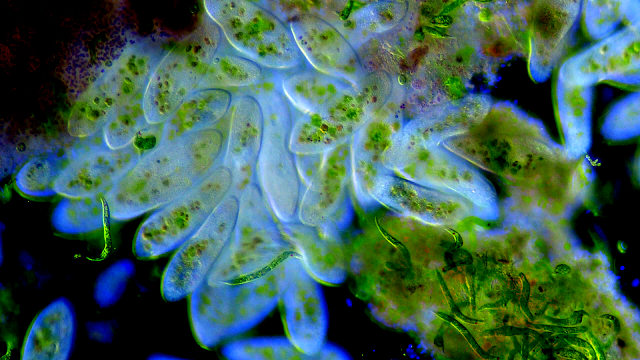IN SEARCH OF IMMORTALITY
The search for immortality has been one
of the obsessions of human beings since they became aware of their own death.
Leaving aside any other approach, and looking
at it from a purely biological point of view, we can consider any living being
as a physical system. And, consequently, subject to the laws of the physical
world.
One of the most important laws in this field
are the laws or principles of thermodynamics.
The first, perhaps the best known, states that
energy is neither created nor destroyed, it only transforms. And the second,
expressed colloquially, says that any physical system has a tendency to
spontaneously become disordered.
In principle, these laws are applicable to any
closed system, that is, isolated from the environment.
However, living beings are not closed systems.
We maintain a permanent exchange of matter and energy with our environment. And
thanks to this exchange we can escape the thermodynamic yoke and maintain our
“order”, at least for a certain time.
Maintaining this order is what we call homeostasis,
and it is what allows us to stay alive in a constant state of dynamic
equilibrium.
But what happens when we are unable to maintain
this balance?
Well, we become disordered and, finally, we
die.
Why do we become disordered? Why do we lose the
ability to maintain homeostasis?
All living beings today store genetic
information in the form of DNA.
Eukaryotic organisms, like us, have our DNA
protected within the nucleus of our cells and organized into small packages.
Each of these packages is what is called a chromosome.
Studies on the aging and death of
our cells have shown that it is precisely in this way of organizing our DNA
where the problem lies.
Chromosomes are made up of linear DNA
molecules, and at the ends of each of them there is a portion of DNA called a telomere.
This portion is what prevents the different chromosomes from linking together
at the ends during cell division. But every time a cell divides, the telomeres
of its chromosomes get shorter. Eventually, after a certain number of
divisions, the telomeres are so short that the DNA in the chromosomes cannot be
duplicated properly, the cell cannot divide, and it dies.
This process of cell death is called apoptosis.
And the number of times a cell can divide before dying is called the Hayflick
limit, and it varies from organism to organism.
For most of our cells, this limit is around 60
divisions. However, we have cells that can overcome it.
These cells are germ cells -which give
rise to ovules and sperm- and stem cells, which can divide indefinitely.
Does this mean that these cells are immortal?
Apparently so. Sometimes, other cells in our
body are able to avoid the Hayflick limit and begin to divide uncontrollably.
When this happens, we face a serious problem: cancer.
As explained by Professor Pedro Luis
Fernández, Head of the Pathological Anatomy Service at the Germans Trias i
Pujol Hospital, "the term cancer is a Latin word meaning crab, and it
is how ancient Greek and Roman physicians called lesions that were destructive
to the body and that usually had the shape of this animal.
The origin of cancer is found within the body's
own cells. Some of these cells can undergo changes in their normal behavior and
behave in an aggressive manner. These are what we call cancer cells.
The common characteristics of cancer cells are
multiple, but three stand out:
The first is that they can evade programmed
cell death, what we call apoptosis, and therefore they can live much longer
than normal. The second is that they can multiply much more quickly and many
times more than normal, exceeding what we call the Hayflick limit. In addition,
if we put these cells in culture and provide them with the appropriate
nutrients, we can say that they become immortalized.
And finally, a third characteristic would be
that, as they are cells that arise from the organism itself, they are able to
evade the systems that recognize them as foreign and, therefore, evade that
death produced by the organism itself, among which the evasion of the immune
surveillance system stands out.
We can compare this cancerous process, using
the famous Ridley Scott film, to an alien. An alien that emerges, grows, feeds
and can eventually kill the organism. But it is a selfish entity, a stupid and
suicidal entity, because it will eventually kill its source of subsistence,
since, unlike what happened with the entity in the film, it cannot pass from
one individual to another.
Or can it?
There is what specialists call hereditary
cancer, but, in reality, it does not pass from one person to another at the
time of reproduction, what it means is that the reproductive cells, the eggs or
the sperm, can harbor genetic alterations that can be transmitted to the
offspring without necessarily meaning that they will suffer from cancer. It may
simply happen that, throughout an individual's life, and due to external
influences, such as carcinogens, other genetic alterations occur that end up
developing a malignant disease, cancer, which usually occurs in adults.
The appearance of cancer causes an imbalance in
the organisms that suffer from it, a loss of their homeostasis, of their
ability to self-regulate and maintain their normal functioning. However, the
apparent “immortality” of cancer cells gives us some clues to find possible
ways to achieve the long-awaited immortality."
Since its appearance on the planet, life has
diversified enormously. Biological evolution, always in response to the
evolution of the planet itself, has given rise to the appearance of numerous
life forms. And each of them has developed a unique, singular way of
maintaining its homeostasis.
Is it possible that any of them has managed to
avoid disorder and, consequently, death?
The answer to that question will surely have to
be sought in life forms much older and simpler than us.
Protozoa and microalgae, all eukaryotic
organisms formed by a single cell, have inhabited the planet since long before
animals appeared. So we could think that they have had much more time to look
for a solution to the problem.
Have they found it? Have they managed to be
immortal?
Organisms as seemingly simple as protozoa are
capable of dividing more than 200 times, many more times than our normal cells.
They also have their DNA organized into chromosomes like ours, and those
chromosomes also have telomeres at their ends.
How do they prevent those telomeres from
shortening?
The secret lies in an enzyme, a molecule that
rebuilds telomeres after each division. That apparently “magic” molecule is
called telomerase.
That same enzyme appears in our germ cells, our
stem cells and, unfortunately, also in cancer cells.
However, it has been proven that protozoa such as paramecia also suffer senescence, that is, they also age and end up losing their reproductive capacity. Therefore, it seems that these organisms have not achieved immortality either.
All the organisms we have talked about so far
are made up (we too) of eukaryotic cells, cells with a nucleus and with
DNA organized in the form of linear chromosomes. But what about bacteria
and archaea?
Bacteria and archaea are prokaryotic
organisms, they do not have a defined cell nucleus. And their genetic material,
their DNA, is not packaged in linear chromosomes, but forms a single circular
chromosome.
Being circular, the bacterial chromosome has no
ends and, therefore, no telomeres, so it does not suffer shortening during the
cycles of division and reproduction.
We might think, as has been thought for a long
time, that, due to this characteristic, bacteria and archaea are immortal.
However, recent studies carried out with one of the best-known bacteria, the
famous Escherichia coli, have shown that this is not entirely true. Some
of the cells resulting from the division of this bacteria, from its
reproduction by bipartition, show a lower reproductive capacity than
that of their sisters, that is, they age and, finally, their line of descent
ends up disappearing.
It seems, then, that neither reproduction by
bipartition, nor the possession of a circular chromosome, without telomeres,
ensures immortality.
Is there any other strategy? Is there any other
possibility of being immortal?
Some groups of bacteria, including those that
make up the genera Bacillus and Clostridium, have the ability to
form endospores as a resistance strategy when environmental conditions
are not suitable.
We could consider these bacterial endospores as
tiny “time capsules” inside which the bacteria remains in a “dormant” state.
When environmental conditions become favorable again, the spore opens,
germinates, and the bacteria inside it reappears.
The question then is how long can the bacteria
remain inside the spore in this “dormant” state?
In 1995, California researchers published the
“resurrection” of a bacteria, or rather, the germination of one of these
bacterial spores, found inside the intestine of a bee preserved in amber for more
than 25 million years. (Cano,
R. J. and Borucki, M. K.: 1995, Revival and Identification of Bacterial Spores
in 25–40 Million-Year-Old Dominican Amber, Science 268, 1060–1064.)
But there is more.
Five years later, in 2000, another American
group of researchers published a study in which they claimed to have
“resurrected” another bacteria. This time the spore was contained in a salt
crystal extracted from more than 500 m deep in the Salado geological formation
in New Mexico. It was 250 million years old. (Vreeland, R. H., W. D. Rosenzweig and D. W.
Powers. 2000. Isolation of a 250 million-year-old halotolerant bacterium from a
primary salt crystal. Nature. 407 (6806): 897-900.)
Is this immortality?
You can watch the episode “In search of
immortality” (25 minutes. O.V. in Spanish. Subtitled in English) of our series
“Planeta microbio” through this link:








Comentarios
Publicar un comentario